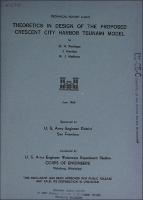Please use this identifier to cite or link to this item:
https://hdl.handle.net/11681/13445| Title: | Theoretics in design of the proposed Crescent City Harbor tsunami model |
| Authors: | United States. Army. Corps of Engineers. San Francisco District Keulegan, Garbis H. (Garbis Hovannes), 1890-1989 Harrison, John, 1939- Mathews, Michael J. |
| Keywords: | Crescent City Harbor Crescent City California Hydraulic models Tsunamis Water waves Mathematical models Numerical models |
| Publisher: | Hydraulics Laboratory (U.S.) Engineer Research and Development Center (U.S.) |
| Series/Report no.: | Technical report (U.S. Army Engineer Waterways Experiment Station) ; H-69-9. |
| Description: | Technical Report Abstract: The important wave parameters to be considered for tsunami model studies are wave height and period, and wave-front orientation. The first two of these parameters can be determined by marigraphic measurements or by visual observations; however, wave front orientation has never been accurately observed at the problem site (Crescent City: Calif.). A digital computer program was written to plot wave rays from three recent epicentral locations to Crescent City to obtain approximate tsunami-front orientations. The refraction diagrams were checked by comparing the computed and actual arrival times of the wave fronts. The actual arrival times were obtained from recording tide stations at Crescent City and Hilo, Hawaii. Initial wave-front orientations near the earthquake epicenter were either assumed or taken from the literature. The frequency distribution of wave heights at Crescent City is a necessary consideration in the overall study. The period of record for tsunamis at Crescent City is too short to determine the frequency distribution of the wave heights; thus, an attempt was made to correlate the tsunami records from particular stations in the San Francisco and Hilo Harbor areas so that the Crescent City record could be artificially lengthened. Correlation between the Hilo Harbor and Crescent City data indicates that the 1964 tsunami at Crescent City was abnormally severe. Effects of distance on wave-height attenuation were investigated and compared with theoretical predictions. On the basis of these considerations, a tentative frequency relation was derived and a risk-duration relation was prepared from the frequency relation. The selected values of the test-wave dimensions (height and period) and orientation determine, to a considerable extent, the model configuration necessary to ensure results sufficiently accurate for purposes of the model study. Since experience in the design and operation of long-period wave models is scant, it was deemed necessary to conduct preliminary tests utilizing a pneumatic wave generator in a two-dimensional flume. The results of these tests were compared with theoretical predictions from an idealized mathematical model and on the basis of these tests, a preliminary model design was proposed. Further two-dimensional testing is deemed necessary before a satisfactory design of the three-dimensional model can be accomplished. |
| Rights: | Approved for public release; distribution is unlimited. |
| URI: | http://hdl.handle.net/11681/13445 |
| Appears in Collections: | Technical Report |
Files in This Item:
| File | Description | Size | Format | |
|---|---|---|---|---|
| TR-H-69-9.pdf | 9.56 MB | Adobe PDF |  View/Open |